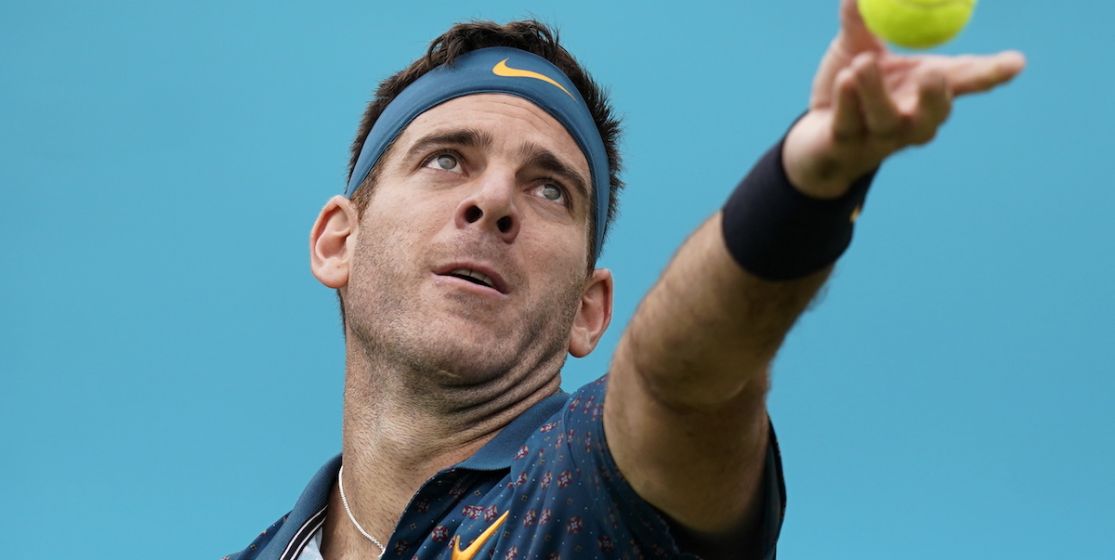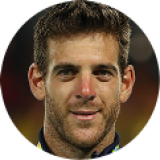Resilience: one’s capacity to psychologically stand the ordeals of life, to bounce back and to start anew after a trauma. Synonym: Juan Martin Del Potro, a man who fell eight times and always picked himself up, a player whose career is made of stunts and tears, of injuries and redemptions. His ATP ranking speaks for itself. In 2009, he was world number 5. A year later, he was ranked No 258. In 2012, he was No 7 and fell to 590 in 2015, only to get back up to No 11 two years later. There is a simple explanation to that: the 33-year-old Tandil-born suffers from weak wrists and knee. He went through more surgeries (8) than he played Grand Slam semis (6). But beyond these figures remains the conviction that he could have achieved way more without these many injuries. It is Marcelo Gomez’s opinion anyway. In the mid-90s, he was the one who saw 6-year-old Del Potro play tennis for the first time with Independiente de Tandil, an average town’s club in the Buenos Aires Province. El Negro Gomez soon realized Del Potro was something special: “Every shot seemed easy to him, and he was a very fast learner. He was only 10 but I knew he’d be in the world’s best 10 someday.” Funnily enough, Juan Martin Del Potro was still hesitant back then; he had to choose either tennis or football. Despite him being way taller than all the kids of his age, the Boca fan was quite good with a ball in his feet, so much that he scored many goals with the Independiente de Tandil youth teams. Ironically, he was advised to pick tennis by a football player.
“If people boo you, it means you are good…”
Juan Martin was barely 10 years old and was playing an important tournament in Brazil. While he was facing a Brazilian player in the final, the crowd started to insult him. The guy who went by the funny nickname of El Enano (“the Midget”) – typical Argentinian humor – gave up. He cracked under the pressure and the heat. He was even taken out of the court on a stretcher, crying. A few hours later, he met someone who would change his life in an airport: Paraguayan goalkeeper José Luis Chilavert, who went to him and said: “If people boo you, it means you are good, and they are afraid of you. You cannot imagine how often people insult me. But that’s because I am good.” These words were enough to convince young Del Potro. For the first time in his life, he started to follow a convergence line he would follow all along his career: falling and picking himself up. Back in Tandil, Juan Martin Del Potro chose tennis. He was coached by Marcelo Gomez, who was happy to shape the rough diamond. “I knew he was very tall, very strong, and he could not play six feet behind the line, just like every other player in Argentina. So, I taught him how to hit the ball in its rising phase, before the line, straight, with no spin. I told him to use a continental grip and to develop a rough surface-friendly style, even though there were only clay courts in Tandil.” Then, Delpo got used to winning matches against players who were two years older. He was played up in every age category and was as powerful as quick. “I think football made him more comfortable in the way he moved,” says Marcelo Gomez. “We maximized this by working hard on his coordination. The idea was to help him improve defensively despite his size.”
Legend has it that Tandil is a special place. How could you explain that this town, which is lost in the middle of the Pampa and where asados are a cult, had so many high-level tennis players? “Five local players were in the Top 100 at the same time: Maximo Gonzalez, Junqueira, Monaco, Zabaleta and Del Potro. Yet, there are only 150,000 people here,” says Gomez. Today, the town is even considered the capital of Argentinian tennis by some. Eduardo Puppo, a historian who specializes in Argentinian tennis, tries to explain: “I don’t know their secret, but many factors come into play. The weather is perfect to play tennis, the town is quiet and peaceful. It is a wonderland for tennis enthusiasts.” A remote wonderland, then. “Tandil is quite remote indeed, but we were born there, it is the way it is. It takes twice as much work to get ahead. Nothing is easy for Tandil people. French tennis wonderkids can get a wild card for the French Open or any other domestic tournament. There is no such thing here,” says Marcelo Gomez. Though he was talented, Del Potro had to feature in all the obscure Future tournaments in South America and play all the qualifiers and Challengers to make a name for himself. From Montevideo to Cordoba by way of Antofagasta, people saw the rising of a star angry to see players of his age who were not as good as him getting ranked above him faster. Gomez sticks to his guns: “We have to fight harder and follow the toughest path but, in the end, it makes you stronger.” Juan Martin Del Potro’s resilience grew in Tandil and nowhere else.
Being sensational again
From 2007 to 2008, the 20-year-old son of a semi-professional rugby player became more and more important. Tennis fans usually agree that a typical Argentine tennis player is a hard-fighter and a relentless clay specialist. But not Del Potro. He is totally different; he is a 6-ft-6-in phenomenon with an exceptional forehand. As strong as a bull, as swift as a puma. “His style surprised everyone. It was a mix of power and consistency, which is unusual for a player this tall,” says Eduardo Puppo. “He moves and defends really well, not only horizontally but also vertically. It is very difficult for players of his size and weight. He is extraordinary in terms of power too. I don’t think I’ve ever seen anyone with such a violent drive, yet I’ve seen guys like Lendl or Gonzalez who were masters of this stroke.” Del Potro’s style was as destabilizing for opponents as pleasant for the crowd. The Tower of Tandil won his first tournaments in Washington, Los Angeles, Kitzbühel and Stuttgart. He even played the 2008 Masters.
2009 was the year of confirmation. Juan Martin Del Potro won the US Open thanks to a superlative tennis. He became the first-ever player to beat Roger Federer – then World No 1 – in a final. He also became the first not-big-four player to win a Grand Slam tournament since Marat Safin in the 2005 Australian Open. People started to see him as the new member of this private club, alongside Federer, Nadal, Djokovic, and Murray. Winning a Grand Slam tournament at the age of 20 is both a great feat and, supposedly, the beginning of something amazing. But for Del Potro, it happened to be the start of his problems. His wrist started to hurt but he suffered in silence through the first part of the season, before going through surgery in May, followed by eight months without playing. He then slipped to the 485th spot of the ATP ranking. But Del Potro rose from his ashes for the first time in 2011, a year that sums up his career perfectly. He was back with the same purpose: becoming the very best, his uncanny mental strength being his secret weapon. “He is the only guy I have ever seen entering the court thinking he is favourite against Federer. When he starts a match, he is convinced that he is going to win. I have never seen such a strong self-belief,” explains Gomez, his first coach. On 27th February 2011, a year and a half after the US Open, the Tower of Tandil won the Delray Beach tournament against Janko Tipsarevic. “For the first time, he showed that despite injuries, his quality and high level of tennis could get him back to his best after a long period without playing. He came back straight where he was supposed to be.” I.e., the world’s top 10. It was the first of his many comebacks.
Since his first return to favour and over the past 10 years, Juan Martin Del Potro’s injury-wrecked career has been a series of dizzying falls down the depth of the ATP ranking, brave rehabs, and comebacks to the top of world’s tennis. But what does push him to relentlessly pick himself up while most players would just give up and accept their fate? Puppo might have the answer: “He knows he has what it takes to reach purposes that are almost impossible to achieve for many. He is carried by the faith of those who think they are special. So, he just never gives up. He must try until his body stops. Juan Martin thinks he still can make it, and nobody will stop him from trying.” Del Potro has not played a single tournament for two years and a half, due to three knee surgeries. Can he make it once more now that he is 33? This is a legitimate question, the weight of the surgeries being harder to carry, the mental load being barely tolerable. Del Potro himself says: “Rehab is the toughest match I’ve ever had to play…” But his family and friends are sure that, if he comes back, he won’t be just a walk-on part. “He dreams of playing and beating the best players in the world. He wants this and nothing else. He has always told me that, if he comes back, it is to be sensational again. If his knee leaves him alone, then I am sure he will come back in force and take his place back among the best players,” says Marcelo Gomez before adding, uncertainly: “Otherwise…”









